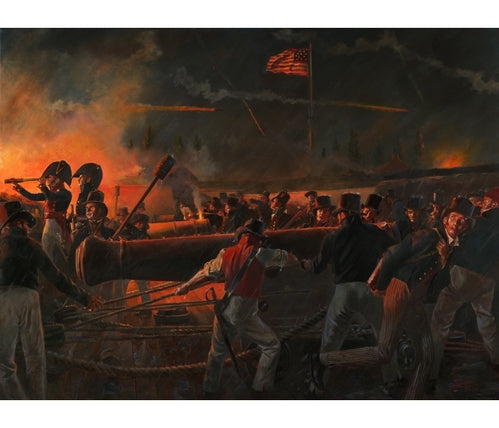W.Britains
Our Flag Was Still There
Our Flag Was Still There
Couldn't load pickup availability
This is Don Troiani print - Our Flag Was Still There.
Available Format of Print:
350 Signed/Numbered (available)
Overall: 30.75" x 24.25"
Image: 26.75" x 20"
$225.00
Artist Proof (available)
75 Signed/Numbered
Overall: 32.5" x 25"
Image: 33" x 24"
$250.00
Canvas Giclee (printed as ordered)
50 Signed/Numbered
Overall: 35" x 25"
$750.00
The defense of Fort McHenry, September 13-14, 1814
(Commissioned by the United States Army War College graduating class of 2012)
The situation in the Chesapeake Bay for the American cause looked dire indeed at the close of August 1814: the Chesapeake Flotilla destroyed, an American army defeated at Bladensburg; Washington sacked and the Capitol building, the White House and the Navy Yard were smoldering ruins, and Alexandria extorted for ransom to prevent similar reprisals. Baltimore appeared to be the next likely objective of the British fleet and expeditionary force, that which had already wrought so much havoc in the region. The city and its harbor--famous haven of privateersmen--was defended by an earthen, brick-faced star fort on Whetstone Point on named Fort McHenry along with a few other smaller works and batteries that ringed the harbor and its approaches from the Patapsco River.
Under the capable leadership of Major General Samuel Smith of the Maryland militia, working closely with U.S. Army and Navy leadership that included Major George Armistead of the U.S. Corps of Artillery and commandant at Fort McHenry, the defenses of the city were bolstered and the mixed force of militia, volunteers, regulars and Navy tars hunkered down for the impending attack. It was not long in coming. On September 11th, the British fleet dropped anchor at the mouth of the Patapsco and the next morning, as transports began to land troops at North Point, the frigates, bombs, sloops and rocket ships of the fleet sailed up river towards Baltimore--opening fire on Fort McHenry at the crack of dawn from two miles distance. As the exploding mortar shells from bomb ships burst above and fell within the fort and its outworks, the garrison opened up with its own defensive fire at intervals. Although their fire largely fell short, it succeeded in keeping the ships at a distance where their bombardment was rendered less effective. The fort's garrison, consisting of one company of regular artillery and two of Sea Fencibles, had been previously augmented by three companies of Baltimore volunteer artillery, 60 sailors from the Flotilla, and 600 infantry drawn from the 12th, 14th, 36th and 38th Infantry Regiments. The heavy guns of the Water Battery and the other lower works were manned by Flotillamen, Sea Fencibles and Baltimore artillerists, with the fort properly manned by regular artillery and one volunteer company; the infantry remained in the outer ditch, waiting for the amphibious landing that was anticipated.
The bombardment of bombs and rockets continued into the night, the weather "thick & hazy with frequent showers of rain". At approximately 1 AM on the 14th, it was discovered that a flotilla of 20 cannon- and rocket-armed barges was attempting Ferry Branch on the fort's right, but a well-directed fire--principally from Forts Covington and Babcock--forced them back and into the firing path of the heavy French 36-pounder cannon of the Water Battery--manned by expert gun crews of Flotillamen under Sailing Master Solomon Rodman--which opened a devastating fire upon the retreating British, by means of aiming at "the blaze of their Rockets and the flashes of their Guns". Seen here, Major Armistead and Captain John Berry of the Washington Artillerists join Rodman at his post (seen behind them between two guns) to observe the effect of this withering crossfire. Behind them, the fort's storm flag is illuminated in relief by the "bombs' bursting in air" and the "rockets' red glare". While the bombardment continued intermittently during the remaining hours of darkness, it ceased soon after daylight, at which time (following established military custom) the storm flag was taken down and the fort's massive garrison flag--today's Star-Spangled Banner, was hoist up--and thus, became witness to the British fleet weighing anchor two hours later.
James L. Kochan
Share


Continue Shopping
See more of the Breagans' collection of manufacturers from all around the world
Subscribe to our emails
Subscribe to our mailing list for insider news, product launches, and more.

